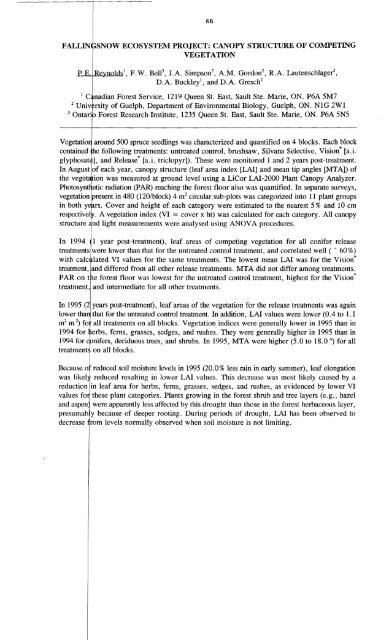Vol. 51â1997 - NorthEastern Weed Science Society
Vol. 51â1997 - NorthEastern Weed Science Society
Vol. 51â1997 - NorthEastern Weed Science Society
You also want an ePaper? Increase the reach of your titles
YUMPU automatically turns print PDFs into web optimized ePapers that Google loves.
---------+<br />
66<br />
FALLIN SNOW ECOSYSTEM PROJECT: CANOPY STRUCTURE OF COMPETING<br />
VEGETATION<br />
PE<br />
R<br />
Vegetatio around 500 spruce seedlingswas characterized and quantified on 4 blocks. Each block<br />
contained e following treatments: untreated control, brushsaw, Silvana Selective, Vision" [a.i.<br />
glyphosat ], and Release" [a.i. triclopyrj). These were monitored 1 and 2 years post-treatment.<br />
In August of each year, canopy structure (leaf area index [LAI] and mean tip angles [MTA]) of<br />
the vege ion was measured at ground level using a LiCor LAI-2000 Plant Canopy Analyzer.<br />
Photosynt etic radiation (PAR) reaching the forest floor also was quantified. In separate surveys,<br />
vegetation resent in 480 (120/block) 4 m 2 circular sub-plots was categorized into 11 plant groups<br />
in both y rs. Cover and height of each category were estimated to the nearest 5 % and 10 em<br />
respectivel . A vegetation index (VI = cover x ht) was calculated for each category. All canopy<br />
structure d light measurements were analysed using ANOVA procedures.<br />
In 1994 1 year post-treatment), leaf areas of competing vegetation for all conifer release<br />
treatments were lower than that for the untreated control treatment, and correlated well ( - 60%)<br />
with calc lated VI values for the same treatments. The lowest mean LA! was for the Vision"<br />
treatment, and differed from all other release treatments. MTA did not differ among treatments.<br />
PAR on t e forest floor was lowest for the untreated control treatment, highest for the Vision"<br />
treatment, and intermediate for all other treatments.<br />
In 1995 (2 years post-treatment), leaf areas of the vegetation for the release treatments was again<br />
lower th that for the untreated control treatment. In addition, LAI values were lower (0.4 to 1.1<br />
m 2 rn") fo all treatments on all blocks. Vegetation indices were generally lower in 1995 than in<br />
1994 for erbs, ferns, grasses, sedges, and rushes. They were generally higher in 1995 than in<br />
1994 for c nifers, deciduous trees, and shrubs. In 1995, MTA were higher (5.0 to 18.0°) for all<br />
treatment on all blocks.<br />
Because 0 reduced soil moisture levels in 1995 (20.0% less rain in early summer), leaf elongation<br />
was likel reduced resulting in lower LAI values. This decrease was most likely caused by a<br />
reduction in leaf area for herbs, ferns, grasses, sedges, and rushes, as evidenced by lower VI<br />
values fo these plant categories. Plants growing in the forest shrub and tree layers (e.g., hazel<br />
and aspen were apparently less affected by this drought than those in the forest herbaceous layer,<br />
presumab y because of deeper rooting. During periods of drought, LAI has been observed to<br />
decrease rom levels normally observed when soil moisture is not limiting.
















